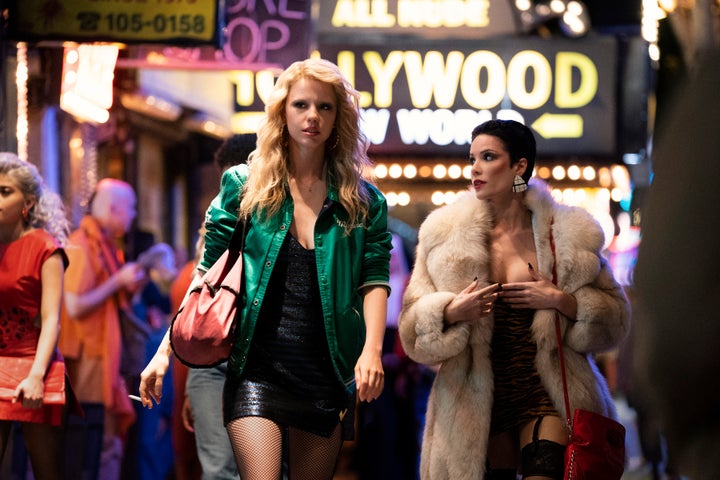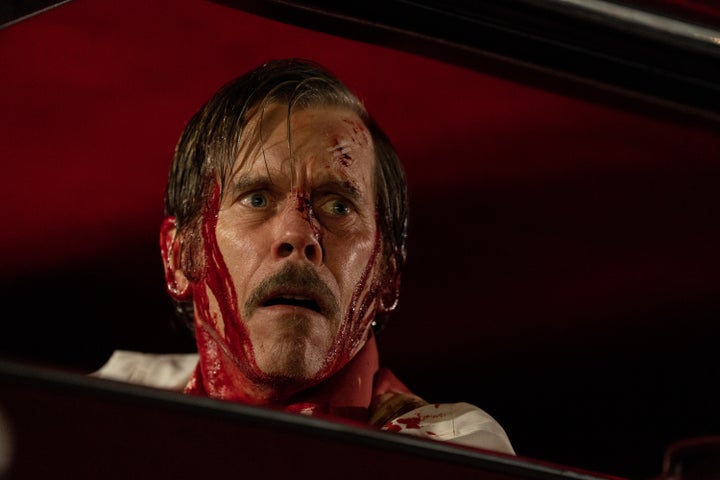Entertainment
This Blood-Soaked New Horror Film Masterfully Brings Back ’80s Grime

In the opening scenes of 1990’s “Pretty Woman,” Julia Roberts’ character Vivian Ward, a sex worker in Hollywood, rehabs well-worn black thigh-high leather boots with nothing but a safety pin and a magic marker, pairing them with a blue-and-white spandex cutout dress and a short blonde wig. It’s resourceful, hot and altogether looks like it totals about $11.95.
While “Pretty Woman” is a quintessential ’90s movie, it reflects a fading 1989, the year it was filmed — down to the cheap, Rodeo Drive-adjacent sleaze, the just-out-of-reach dreams and the dead woman’s body in a dumpster that smiling tourists can’t stop snapping photos of.
And, most interestingly — within its first 30 minutes, even — it scrubs off the grime of the ’80s to morph into a “Cinderella”-esque romcom classic that helped usher in a cleaner, more gentrified ’90s era. (Coincidentally, “Pretty Woman” was conceived as a much darker crime drama before it became what it did).
It’s fascinating to think about that movie alongside “MaXXXine,” writer-director Ti West’s dazzling, 1985-set Hollywood horror threequel so entrenched in the filth of that time that it’s hard to imagine how anyone then could have fathomed a way out of it.
The camera trails Maxine Minx (the superb Mia Goth), a sex worker and wannabe movie star, as she swaggers down some of the same streets Vivian does in similarly tacky-chic clothes, giving audiences an unflinching look at Hollywood in the mid-’80s. In a dizzying blur, we see X-rated video stores; seedy alleys; run-down establishments and graffiti galore.
Hulton Archive via Getty Images
And, like Vivian, the sight of a familiar corpse outside her building unnerves her but fails to break her stride.
Meanwhile, the rhetoric of the conservative Moral Majority and puritanical culture of the Reagan era — which was also a theme of the ’70s-set “X,” the first film in West’s trilogy — continues to reverberate on TV sets and protests. (While few things compare to the open ire of sexuality in film during that time, remnants of that persist today).
Where 2022’s terrific “X,” in which Goth, Jenna Ortega, Scott Mescudi and others portray a porn film crew on a soon-to-be blood-bathed set in Texas, sharply engaged with and challenged the politics of its time, “MaXXXine” simply lives it. And it’s just as good for it.
Maxine slyly survived the events of “X” — its sequel, the eponymous “Pearl,” also released that year, needlessly told the origin story of the Bible-thumping hag that tried to kill her. Now in the thrilling conclusion, “MaXXXine,” she’s this close to achieving her Tinseltown dreams.
Without a concentrated prequel of her own for audiences to pull from, it was initially unclear exactly which direction West would take for this film. Murder and mayhem was to be expected, as that’s what the previous films wrought. The connected taboos of smut films and slashers would also likely be, and are, a carryover from “X.” But what is Maxine’s deal, actually?

For one thing, we get a satisfying peek at stop-at-nothing ambition that comes from a woman’s deranged upbringing. But “MaXXXine” does a lot more than give us a wildly determined actor who clawed her way out of a porn film massacre in the ’70s to find herself, well, still doing sex work, but in line to become the next great thing in a more traditional Hollywood project.
What makes the movie so engrossing, particularly as a supposed nod to “Pretty Woman,” is that it’s an equally unconventional Hollywood tale (both center female sex workers who pull themselves up by their tattered bootstraps and go straight), but “MaXXXine” is soaked in ’80s muck. And it compels its protagonist, and the audience, to navigate that for 104 minutes.
The film’s grime is not only in Maxine’s casual cocaine sniffing, her fried blonde hair that’s teased to the gods, her black fishnets and flashy, potentially drugstore-brand makeup, or the film’s flashy soundtrack featuring Madonna, Soft Cell and Frankie Goes to Hollywood.
“MaXXXine” also has extremely ’80s camp. Giancarlo Esposito dons gaudy red hair as Maxine’s batshit agent; Kevin Bacon has goofy gold teeth as the trashy private eye who knows Maxine’s unhinged past; and Michelle Monaghan and Bobby Cannavale play detectives who banter like two rejects from “Moonlighting.”
Adding to that, West grounds the film with the still relevant, precarious nature of (albeit mostly white) female mortality — particularly sexualized female mortality — in a landscape that idolizes and destroys it in equal measure. In “MaXXXine,” he embeds the very real ’80s threat of the Night Stalker serial killer that terrorized Los Angeles in 1985 and dropped dead bodies all over town.

So in comes the emblematic ’80s gore.
Gunshots that splatter people’s brains all over the place. A single stiletto heel tramples one man’s balls to mush. Several characters are dismembered. “MaXXXine” borrows a lot from the threadbare visual effects of films like “Friday the 13th,” “The Evil Dead” and “Prom Night,” offerings that were similarly bound to smaller budgets than most studio films.
A popular explanation for that is because horror films don’t have the prestige of other genres, and therefore don’t get the same financial support — despite many that have performed well at the box office over the last few decades. They’re continuously made to satiate the growing demands of the audience, yet don’t often have the funds as, say, a “Star Wars” project.
Those constraints all work in favor of “MaXXXine,” though. It feeds off the scrappy, sordid appeal of the ’80s and refines it into a fresh, meaningful film with committed performances — including Elizabeth Debicki and Moses Sumney in supporting roles — that is a good reminder that muck, horror and storytelling can coexist and be good at the same time.
That seems to have always been West’s impetus for this trilogy: destigmatizing what is considered sleaze and giving it its rightful place alongside other art.
Even Vivian could probably appreciate that.
“MaXXXine” is in theaters Friday.










